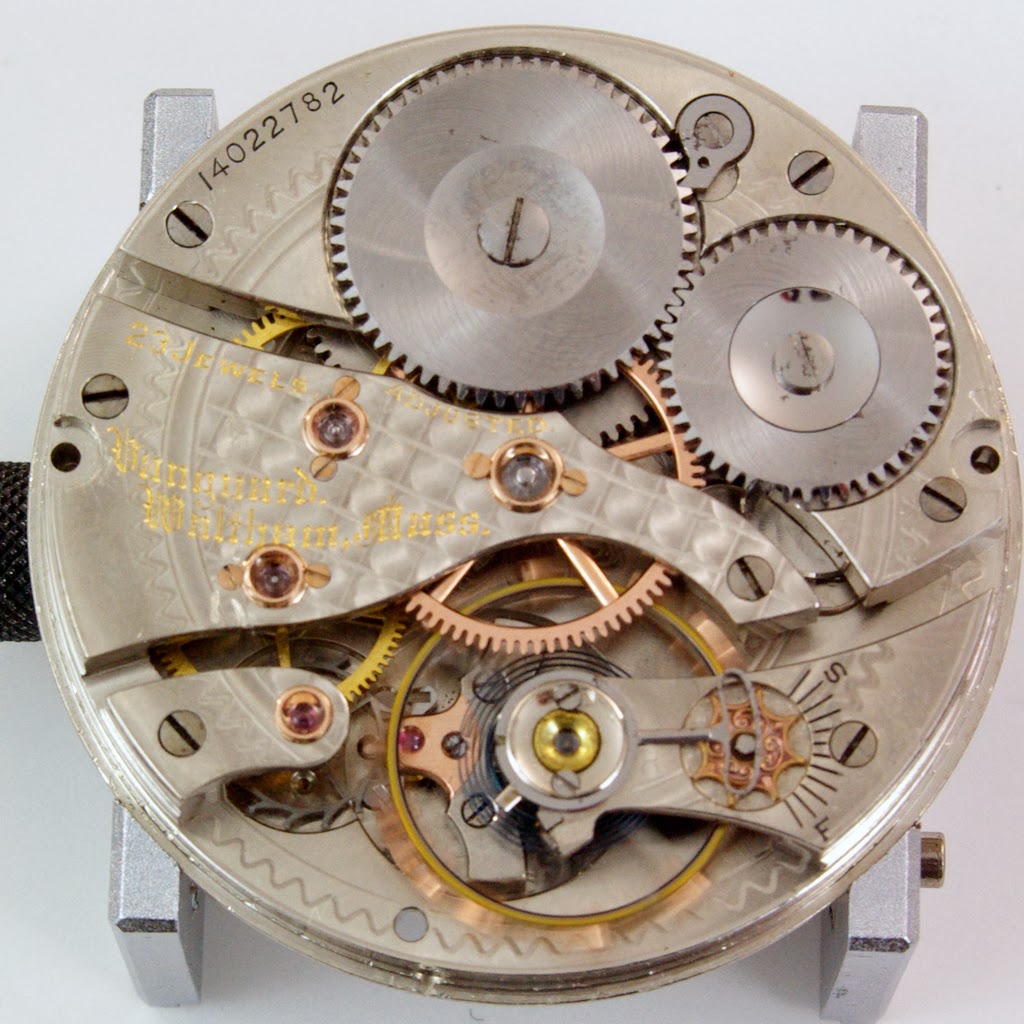.JPG) |
| Face or "Bottom" plate |
Although this is a very high grade watch all of the 1899 & 1908 movements are of the same basic configuration. Click on the image for a much larger picture.
There is not much to say about the bottom plate except to point out the damascening even where you can't see it. Top centre is the winding / setting mechanism controlled by the Lever on the other side.
 Mainspring assembly: This grade of watch has jewels to the mainspring arbour, they are housed in in the top of the barrel (shown centre bottom) through which the two part arbor ("axel") passes. The barrel is top left and the spring fits inside it with the geared lid or top, naturally, on top. The whole is kept together by the little screw thingy bottom right going through the barrel and into the other part of the arbour. On lower grade watches the arbor is in one piece and the barrel and top are not secured together directly but held together by the plates of the movement.
Mainspring assembly: This grade of watch has jewels to the mainspring arbour, they are housed in in the top of the barrel (shown centre bottom) through which the two part arbor ("axel") passes. The barrel is top left and the spring fits inside it with the geared lid or top, naturally, on top. The whole is kept together by the little screw thingy bottom right going through the barrel and into the other part of the arbour. On lower grade watches the arbor is in one piece and the barrel and top are not secured together directly but held together by the plates of the movement. Next we have the part of the frame holding the main top jewels plus the bridge that holds the lever pallet. On this high grade movement the jewel settings are gold and the three larger ones are set using screws rather than pressed.
Next we have the part of the frame holding the main top jewels plus the bridge that holds the lever pallet. On this high grade movement the jewel settings are gold and the three larger ones are set using screws rather than pressed.The lever pallet and escape wheel both have cap jewels (bottom left and on the pallet bridge - but they don't show up very well). The engraving on this model has been highlighted with a gold wash.
 Having been cleaned the movement is now ready to go back together and the main wheels are "planted" into the face plate, the mainspring barrel has been placed early to show how it fits in.
Having been cleaned the movement is now ready to go back together and the main wheels are "planted" into the face plate, the mainspring barrel has been placed early to show how it fits in.Note the steel escape wheel on the Swiss lever escapement ( the lowest in the picture). The centre wheel is gold whilst the other wheels are brass.

It takes a little fiddling about, particularly with the escape wheel with its end jewels making for a very shallow hole to get the pivot into but soon we end up with the movement basically back together and the lever pallet can be put in which is another fiddly job.
 Almost there now and its time to fit the balance. The Vanguard has gold balance screws which gives a heavier balance and better timekeeping but requiring a stronger hairspring.
Almost there now and its time to fit the balance. The Vanguard has gold balance screws which gives a heavier balance and better timekeeping but requiring a stronger hairspring.The double roller can be seen in the centre on the "axel", the main benefit of the double roller is improved timekeeping when being subjected to the normal bumps it will take whilst being worn.
A second advantage (later not usually taken) is that the roller can be made in two parts one of Bronze and the other steel which allows the impulse jewel (just visible at the bottom of the light brown disk) to be set into the bronze without glue - which is not practical in steel - whilst the rest be the stronger metal needed there.
Now for the big moment, the movement is back together and fired up.
And it works! In fact after a few tweaks to the hairspring and an adjustment to the regulator, a quick measurement in this position shows that it may now be accurate enough to pass the original design specification of keeping time to within 30 seconds a week.
However it will need to settle down, be put into its case and then measure in different positions.
So the next thing to do is that case, but a job for tomorrow I think.


2 comments:
This is an excellent blog John.. Don't know how you find the time to do the work that clearly you enjoy and also create this splendid walk through with stunning pictures.Adrian Bruder
Thanks Adrian, the secret is working at it 6 or 7 days a week, and I am meant to be retired! But that will change shortlym the Salmon fishing seasons starts on the Wye in a couple of weeks and the Trout season on the Hampshire chalk streams not that long after so from the 15th of next month (if the rain stops!) I'll be down to 4 or 5 days a week until October :-)
Post a Comment
Note: only a member of this blog may post a comment.